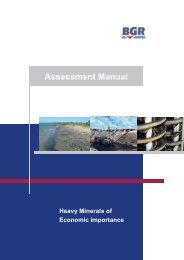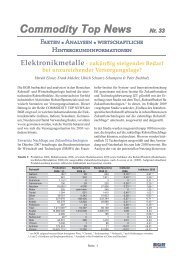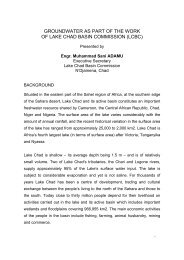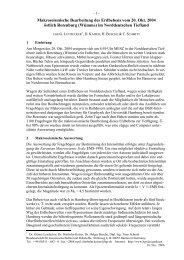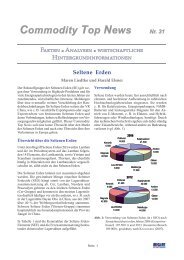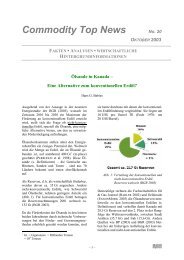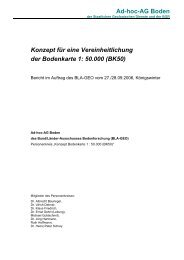THE SMOOTH SOUNDING GRAPH. A Manual for Field Work ... - BGR
THE SMOOTH SOUNDING GRAPH. A Manual for Field Work ... - BGR
THE SMOOTH SOUNDING GRAPH. A Manual for Field Work ... - BGR
Create successful ePaper yourself
Turn your PDF publications into a flip-book with our unique Google optimized e-Paper software.
28<br />
1.6. Shifting of potential electrodes<br />
In using the Schlumberger arrangement the potential electrodes M and N<br />
are left in their position and only the current electrodes are shifted along<br />
the AB-layout. Of course there will be a limit depending on the sensitivity<br />
of the direct voltage amplifier recording the voltage U. This means that<br />
reaching this limit we are <strong>for</strong>ced to enlarge the spacing MN = a. There<br />
then arise consequences from the theoretical point of view and the<br />
change in surface conditions (lateral effects) around the centre point as<br />
well. In this chapter only the theoretical part shall be discussed. We shall<br />
do this by aid of the 4-layer graph from chapter 1.5. We know that ρa de-<br />
pends on the electrode configuration at the surface. There is a difference<br />
between the apparent resistivity ρa (S) after Schlumberger and ρa (W) after<br />
Wenner. In Fig.21 both curves ρa (S) and ρa (W) are plotted in the same L/2-<br />
diagram.<br />
We observe that the Wenner-curve is a bit "lazy" compared with the<br />
Schlumberger-curve: The ρa (W) curve seems to be pushed to the right;<br />
ascending and decending is not as steep as in ρa (S) ; maximum and mini-<br />
mum of ρa (W) are less extreme than in ρa (S) .This is an important fact to be<br />
taken into account when shifting the potential electrodes.<br />
We will follow this process looking at Fig.22. The initial position of the four<br />
electrodes usually is L/2=1,5m, a/2=0,5m, i.e. we start with Wenner.<br />
Enlarging L/2 and leaving the potential electrodes in their initial position<br />
a/2=0,5m. the recorded ρa-data will smoothly change over from ρa (W) to<br />
ρa (S) . We get the curve branch (1).<br />
At L/2=15 m the U-values recorded by the direct voltage amplifier be-<br />
come very low * . We observe that at least at L/2 = 20 m we will have to<br />
shift the potential electrodes. Branch (1) now is running within the real<br />
Schlumberger curve. Changing the spacing a/2 from 0,5 m to 5 m means<br />
a changing over from Schlumberger to Wenner. The ρa (W) -value at<br />
L/2=15m "drops down" into the Wenner-curve, thus starting branch (2).<br />
* This is only assumed <strong>for</strong> the present example. In practice we mostly can<br />
run the first branch up to greater L/2-values.



